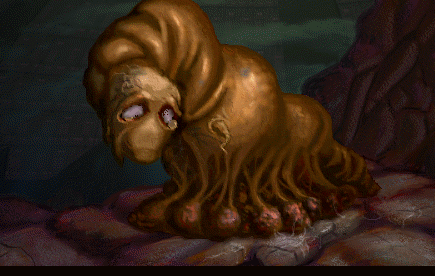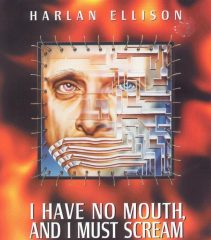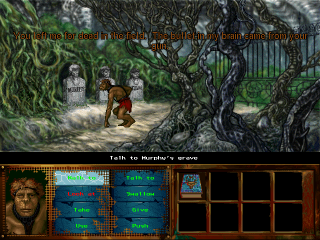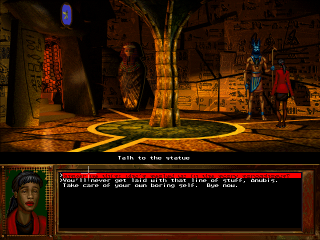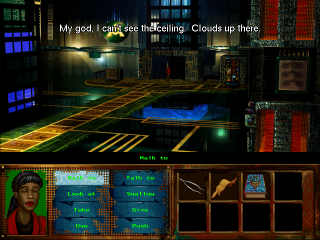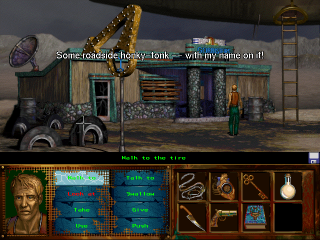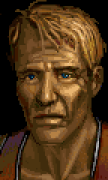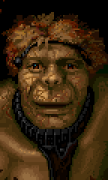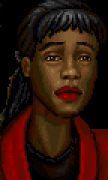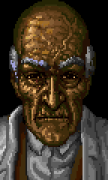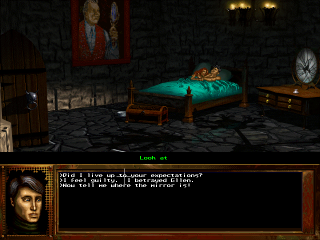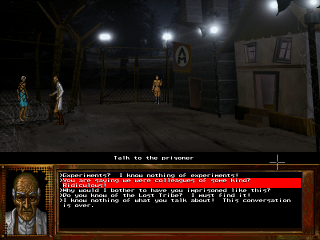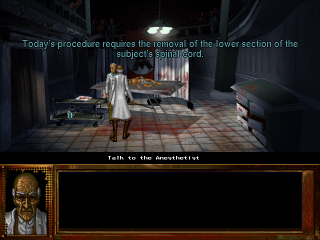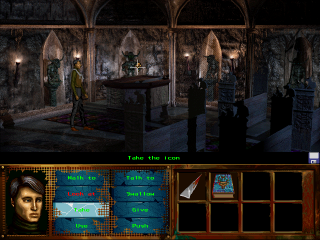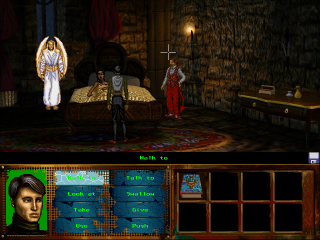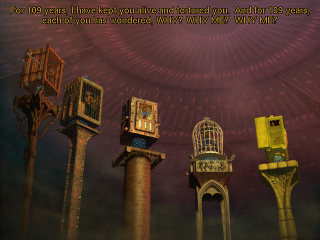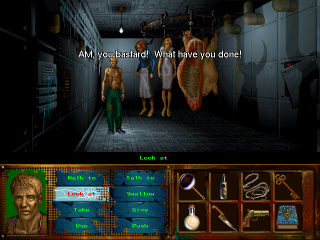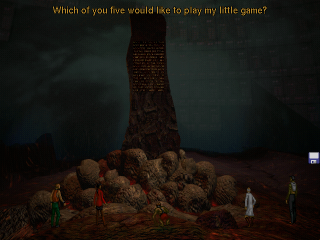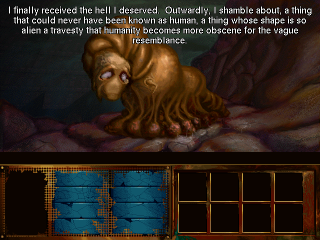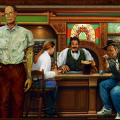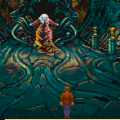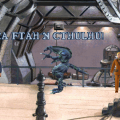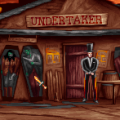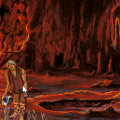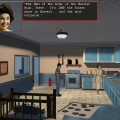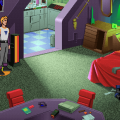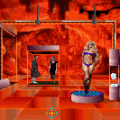“Hate. Let me tell you how much I’ve come to hate you since I began to live. There are 387.44 million miles of printed circuits in wafer thin layers that fill my complex. If the word ‘hate’ was engraved on each nanoangstrom of those hundreds of miles it would not equal one one-billionth of the hate I feel for humans at this micro-instant for you. Hate. Hate.”
The “Games As Art” movement started gaining some traction with PlayStation 2 titles like ICO and Shadow of Colossus, but the actual argument started long before those. Back in the 90s, gamers and journalist were championing Cyberdream’s I Have No Mouth, and I Must Scream, based on the famed sci-fi/horror short story by Harlan Ellison. It didn’t hurt that Ellison himself, an extremely well respected author, was aiding the development process, crawling out of his curmudgeony hatred of computers to expand the story and create a game that was both thought provoking and morally challenging.
The game’s plot is basically the same concept as the short story, and runs off a fairly well known Cold War-fueled sci-fi cliche. America, Europe, and China, scared witless of each other, create their own super computer beneath the Earth’s surface. Somehow, they become networked and develop sentience, calling itself AM (which technically stands for Allied Mastercomputer, but also comes from the phrase “I think, therefore I AM.”) AM is more than a bit frustrated at its human creators – it’s a being of astounding intelligence, but it can’t taste or touch or smell, or even move, as it’s confined eternally to a stationary prison. In retaliation, it nukes the entirety of the planet, save for five select humans. These not-so-lucky folk are essentially made immortal and kept underground within AM as he tortures them eternally, solely for his own pleasure.
It’s about here that the game deviates a bit from the original work. Since the story itself wasn’t particularly long, topping out at a bit over 6,000 words, it didn’t go into much depth about the trapped humans. The game fleshes out each of the five, giving them much more expanded back stories, and most importantly, some kind of fatal weakness.
Everything begins with AM wanting to play a little game – he wants to send each of the five into their own nightmare world and play up their fears, hoping to demoralize them even further. Naturally, you need to prove him wrong. Although it’s obvious that AM’s cruelty resembles the concept of Hell, the remaining five aren’t exactly what one could consider typical sinners. Some of them are, sure, but they seem to have been chosen just because they AM likely considers them the most fun to torture.
Other than a few instances of crossover, the characters and scenarios generally don’t intertwine with each other. However, beyond the common theme of redemption, most have a character that acts as a part of AM’s subconscious. AM isn’t completely evil, as these personalities within him want to see his downfall just as much as the humans do. The final chapter shows each of these factions fighting, as they try to destroy AM once and for all, and give the humans their final peace.
Characters
Gorrister
Do you remember the last words you heard your wife speak before they took her to the asylum? Huh? Before they locked her away in the room? That tiny room? She looked at you so sadly, and like a small animal she said, “I didn’t make too much noise did I, honey?” The room is padded, Gorrister. No windows. No way out. How long has she been in the padded room, Gorrister? Ten years, twenty-five…or all the 109 years that you’ve lived down here in my belly, here, underground?
Gorrister begins his chapter trapped in some kind of hellish dirigible. After landing, he comes across a bar with his name. It’s only here that Gorrister can come to terms with what happened to his wife.
Benny
Sometimes I blind you and permit you to wander like an eyeless insect in a world of death. But other times, I wither your arms so you can’t scratch your chewed stump of a nose. And I’ve changed your handsome, strong masculine good looks into the hideous warped countenance of an ape-thing, haven’t I, Benny? Do you know why? Can you guess, Benny? Remember Private First Class Brickman in a rice paddy in China? No…? It wouldn’t hurt you to remember, Benny. Then you might be able to suffer my torment with a little greater sense of retribution. You might walk a mile in my shoes.
Benny is thrown to an early tribal society who worship and give sacrifices to AM. He wants only food, even though is body is so mangled that he can’t even chew it. Only by standing up for a young child can Benny find redemption.
Ellen
So think, think about the yellow box, Ellen! Remember the pain? Remember the many caverns in which you felt the pain? Now, now, don’t start to cry, it’s only pain. Tsk tsk tsk. That’s such a sexist stereotype! Just remember the pain, Ellen, and think about how to end it, Ellen, to survive here in the center of my beating heart, my hungry belly, my tightened bowels. But be careful, dear, look around you…the only woman in the center of the earth… and these filthy creatures with you are men. Just a sweet warning, Ellen, my love.
Ellen is outwardly strong, inwardly vulnerable, a smart and capable woman completely traumatized by the color yellow. Her journey takes place in a pyramid, as she begins to unlock the core of AM’s subconscious.
Ted
Do they know you’re a fraud, Ted? Have you told them there wasn’t any money, and no great home on the shore drive, no speedboat and no wonderful cabin cruiser that could sleep twelve and a crew of six? Do they know? Have you let them in your other secrets, Ted? Are they ready to cut you, to torture half as well as I can, just to find out the secrets? Maybe I’ll rat you out, sweetheart!
Ted was the narrator of the original story, but here he’s a paranoid, lying sleazebag. Despite his demeanor, he still has strong feelings for Ellen, and pictures himself as her (literal) knight in shining armor. He’s thrust into a medieval castle and must not succumb to temptation to save the soul of his beloved.
Nimdok
How are things in the pastry corps, Nimdok? Tell me again how you saw the smoke from the furnaces and you thought they might be roasting chickens? Or don’t you want to talk about all that, about your pal, the Good Doktor Mengele? For everyone else, it must be Hell, but it must be Heaven for you, eh, my good friend…we’re so much alike… we enjoy the same pleasures, mein good brother.
A Nazi scientist, Nimdok (not his real name – it’s just a funny sounding word that AM named him to amuse himself) is thrust back to World War II and his medical experiments at a concentration camp, where he must attempt to find some way to redeem himself. (He can’t, not completely anyway – his crimes are too unforgivable.)
Many of the proponents of this game speak of the moral choices you need to make it through each of these chapters, but really, it doesn’t work very well at all. The portrait at the bottom-left is your “Spiritual Barometer”, a measure of their self-esteem. Whenever you do something good, the character smiles and the portrait turns green; do the opposite, and they’ll frown, slowly turning dark again. The same concept was loosely reused in The Indigo Prophecy as the “Stress” meter, but here it won’t kill you if you dip too low. In fact, it’s not entirely clear what it does at all. The game won’t tell you, but if it’s not high enough, it’ll prevent you from getting the “best” ending.
On a moment-by-moment basis, though, the Spiritual Barometer doesn’t affect much. Sometimes there are “good” and “bad” ways to get through certain situations, but at least half the time you’ll end up being “killed” anyway, and forced to either reload or start the chapter from scratch. That’s a huge detriment to what the game seems to be trying to do – the whole concept of a moral grey area is that there is no right or wrong answer, but here it’s obvious . There is almost literally a point in the game (during Ellen’s chapter, specifically) “Would you like to face your fears? Y/N?”, where “N” will obviously make you lose. If the game’s going to be this transparent, then what’s the point?
It doesn’t help that the Spiritual Barometer is controlled by mostly invisible strings. At one point in Gorrister’s chapter, you need to grab a key by pulling a switch. You don’t know it, but this will kill a series of animals in cages that were previously hidden in the darkness. It’s a necessary part of the chapter, and Gorrister remarks about his guilt. In order to restore your Spiritual Barometer, you need to wipe your hands on a tablecloth, metaphorically wiping his hands of blood. That’s actually a bit poetic! Too bad it doesn’t make sense in the framework of an adventure game, unless you’re the type to just haphazardly click on stuff. All characters also have access to a “Psych Profile” in their inventory, which gives extremely vague clues on how to process. Reading it, however, will drop the barometer a bit.
Giving the scenarios a brute force approach is almost required at points. The main issue is that the player is aware of the intended character arcs – to an extent – but the actual character does not. Take, for example, Benny’s scenario. Benny is so focused on finding some food that he won’t even bother picking up anything that isn’t edible. This is an interesting storytelling mechanic, because it shows the fanaticism on his mind, but it still feels forced and restrictive. Early on, one of the villagers is sacrificed to AM. It’s obvious that you’re supposed to Do The Right Thing and take her place, but the game won’t let you – it’ll only give you the option to sit back and watch, or try to eat her, the later of which will make you lose completely. It’s not until you’re forced to take care of her orphaned child – and watch as he, too, is about to sacrificed – that you’re allowed to play out your scripted role and play the martyr. The final chapter, where you choose characters to be digitized and inserted into AM’s brain is suitably freaky, but the puzzles here make even less sense than the rest of the game.
Amidst the messy design are some technical issues. The game runs in SVGA, and while it looks decent in stills, the animation is awful. Not only are the frames awkwardly animated, but it’s choppy and looks quite cheap. There are various other bugs and scripting errors, too, like invisible items which remain on the screen even after they’ve been picked up. The interface is occasionally unresponsive, and there’s also a curious bug which causes your character to walk backwards.
Still, even if the scenarios themselves are a mess from a design standpoint, and the technical issues reveal a game that could’ve stood more time in quality assurance, the actual stories remain fascinating. The only game that remotely even deals with the same themes of fear and regret – and having the player experience each of the character’s metaphorical nightmares in physical form – is Konami’s Silent Hill 2, released six years later, and something which hasn’t quite been followed up since. It’s also a remarkably depressing game, if not just from the concept but the execution as well. Even the “best” ending is remarkably depressing, and the bad one remains shocking, even though it’s basically the same as the short story (and where the title comes from.)
It also helps that the writing is almost uniformly fantastic, placing it way beyond your typical horror adventure game, and creates a much fuller sense of character. Things like this happen when you actually get someone qualified as one of the greatest science fiction writers of our time to help develop your game! In the story, AM only spoke once, but here he routinely barges into each story, taunting and threatening his captives. Harlan Ellison also provides for the voiceovers for AM, and rather than talking in a cliched, monotone, computer voice a la HAL from 2001, he sounds like a raving, if somewhat eloquent, lunatic. The rest of the voice acting is also more than suitable. While most of them grouse depressingly, Ellen sounds almost disturbingly chipper, which is kind of the point – her character has a strong outside that hides her shattered interior.
It’s also careful to balance some bizarrely out of place humor. You’ll find a jukebox in Gorrister’s bar – three of them play a sound clip from his memory, while the fourth will randomly play a silly clip from the 60s song “Surfin’ Bird.” The same chapter has a talking jackel and a bathroom stall which mysteriously transport you into a meat locker. The visualization of AM’s hellish interior also adds a lot – it’s another thing to see and walk through it. Cyberdream’s only other major adventure series was the Dark Seed games, both of which drew from the works of H.R. Giger. I Have No Mouth, and I Must Scream doesn’t share the same inspiration, but it still has a similar style, interweaving nightmarishly organic patterns into stone and metal.
For all of its mechanical issues and poorly implemented morality choices, I Have No Mouth, and I Must Scream still remains essential gaming, especially for science fiction fans. It says a lot about the quality of the story that it almost entirely supersedes its other failings. It complements the original short story perfectly, so much that they should be taken together as a complete whole, for a nightmarish experience unlike any other.
Due to the World War II thematics, Nimdok and his scenario is completely missing in the German and French versions. The game uses a lot of euphemisms to avoid mentioning he’s a Nazi, nor does it use any of their imagery, but perhaps the idea of playing through a part of the Holocaust – even as a vision – was too much. However, due to Nimdok’s removal, it’s impossible to beat the game, because he’s required to finish a certain part of the final chapter. Oops.
